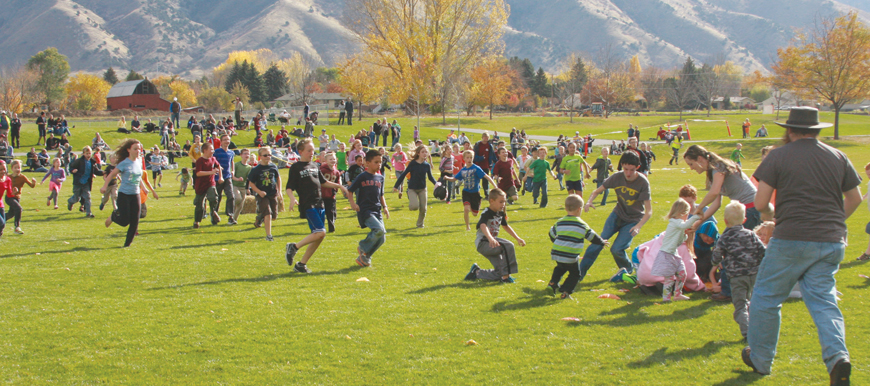Engineers catapult pumpkins in annual toss
Students catapulted candy-filled gourds in the name of engineering and holiday cheer on Saturday at Elk Ridge Park for the fourth annual American Society for Mechanical Engineers Pumpkin Toss.
For the toss, groups formed to create trebuchets, a type of catapult. The teams then met to launch pumpkins into the air, using their prior calculations to determine where the pumpkins would land.
“This is my first year doing it,” said Leland Rasmussen, a junior in mechanical aerospace engineering. After hearing about the toss through an email, Rasmussen said he was intrigued and decided to form a team and build a trebuchet for the event.
Participants could sign up on their own and be assigned to a group, or a prior team can enlist together. After submission, teams have to create a design for the trebuchet.
“First you need to decide on a basic design, what you want to do,” Rasmussen said.
Parker Dahl, a junior in mechanical engineering participated with his own team to create a trebuchet.
“You have to start with an idea,” Dahl said. Various types of trebuchets were seen at the pumpkin toss this year. Dahl’s team went with a traditional trebuchet design. After the basic design was decided, groups had to find funding to make their trebuchets.
Though some teams paid out of pocket, Rasmussen’s group received sponsorships from local car dealerships to support the project.
Dahl’s team also consisted of Spencer Mathias and Robert berry, both juniors in mechanical engineering. Mathias participated in the toss last year.
“They were doing candy pumpkins back then. Still dangerous,” Mathias said.
Most pumpkins were launched for testing purposes, but four or five filled with candy became popular with young spectators, said Tim Brenner, a member of ASME and junior in mechanical engineering.
“When they landed, 70 kids would swarm them,” Brenner said. “Five kids would get the candy and 65 otheres would come back crying to their parents.”
To keep everyone safe from the projectiles, spectators had to stay behind a boundary during the launches. Brenner said this didn’t stop the kids’ excitement.
“They’d be behind the tape ready to sprint out,” he said. “There were kids everywhere, just like a dog pile or a mosh pit of kids.”
Five teams competed in the toss, four from Utah State and one from Brigham Young University. The latter didn’t have much success, Brenner said.
“They broke an arm on it; the webbing broke, too,” he said.
Dahl’s team worked for a month and a half to bring their catapult to life.
“We spent a lot of time, probably more than we wanted to,” Dahl said. Mathias said they gave up a decent amount of studying to make the trebuchet happen.
“It takes a lot of time, but it’s fun,” Dahl said.
The group made changes along the way, however.
“It was kind of a ‘do it as we went’ type of thing,” Mathias said. “We did some calculations, like if the arm was strong enough, but I don’t know how much it actually helped.”
These changes influenced calculations for where the pumpkin landed.
“Our calculations were not as accurate, as they changed as we went through,” Dahl said.
The teams then had to test their catapults before the toss.
“We test fire, tweak, repeat,” Rasmussen said.
The group commended the hands-on opportunities that the ASME has provided.
“This is what I’ve always liked to do,” Rasmussen said. “I grew up making legos, taking apart stuff.”
Dahl’s group said they enjoyed building the trebuchet and participating because of the hands-on aspect and applying the things they learned in school.
“In my free time I’m always wanting to make something,” Dahl said.
The trio plans to make strategic changes for next year’s toss.
“We’ll calculate the stresses next year,” Mathias said. “We’ll do the math next year, and then we’ll know where [the pumpkin is] going to go.”
Overall, the group described their participation in the toss as a good experience.
Rasmussen encouraged people who are interested in engineering to seize opportunities like the pumpkin toss.
“If you want to do something, then just do it,” Rasmussen said.
Mathias also encouraged people to go for the gold.
“Do it until it breaks,” he said.
More information on the ASME can be found at asme.usu.edu
— sadiejherrera@aggiemail.usu.edu

